Apple borers: dogwood, American plum, flat-headed and black stem
Dogwood Borer
Dogwood borer eggs are laid under the bark at burr knots or damaged areas on apple or other host trees. The larvae crawl under the bark and feed on the living tissue of the tree, causing a loss of vigor and eventual death. Burr knots are often found on trees with dwarfing rootstocks, including Malling and Malling-Merton. Damaged areas can be caused by pruning, hitting the trunk with a mower or other farm equipment, or places where branches are rubbing against each other.
| Dogwood borer | |
| Order | Lepidoptera |
| Family | Sesiidae |
| Scientific Name | Synanthedon scitula (Harris) |
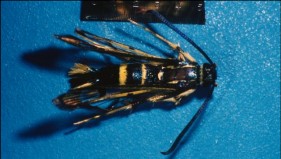
Identification and Damage Symptoms
The adult dogwood borer flies during the day and looks similar to a wasp at first glance, although it is in fact a moth. Larvae are light pink maggot-looking caterpillars with a dark brown head, developing entirely within the tree. There is only one generation of dogwood borer per year, but larval development spans from late June through the following spring, overwintering as a larva inside the tree. Damage generally includes a loss of tree vigor, occasionally culminating in death. Dogwood borer feeding sites often have reddish frass on the burr knot or other damage point, which is similar to that of the American plum borer. These can be distinguished by cutting into the tree to find the larva, which look different (see below for description of plum borer larvae).
Monitoring and Control
Monitoring can be done using pheromone-baited traps at approximately head-height in the trees. Cultural control can include painting a white latex on the trunk of the tree, which discourages dogwood borer females from ovipositing. Additionally, it will help to be aware of which rootstocks are most likely to cause burr knots. Whether using a susceptible rootstock or not, allowing sunlight and air-circulation on the graft union can help minimize the risk of burr knot development. Mating Disruption (Isomate®) is not currently registered for use in Wisconsin. However, Isomate® has been shown in other states to be an effective product, which, unlike traditional mating disruption pheromones, is a repellant to males seeking out females, pushing them out of the orchard. Should the need arise, we will make an effort to get a mating disruption product registered for your use against dogwood borer. Chemical control options are detailed in the table below. There are many other tradenames available, and we do not recommend these that are listed above other options. All product recommendations can be found in the latest Midwest Fruit Pest Management Guide. You should always fully read and follow the label before spraying any pesticide.

American Plum Borer
American plum borer is a pest of cherry, peach and apple in Wisconsin. Similarly to dogwood borer, the American plum borer enters the tree through burr knots or where the bark has been damaged.
| American plum borer | |
| Order | Lepidoptera |
| Family | Pyralidae |
| Scientific Name | Euzophera semifuneralis (Walker) |
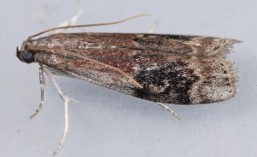
Identification and Damage Symptoms
The adult plum borer is a small brown and white moth, similar to many other pest moths in Wisconsin. Larvae are dark brown to purplish in color. Damage to the tree begins with a loss of tree vigor, and girdling may cause death. Similarly to the dogwood borer, a reddish frass may be seen outside the site of American plum borer feeding; the best way to distinguish between these two pests is by cutting into the burr knot to find the larva inside, as the larvae are very different in coloration.
Monitoring and Control
Monitoring can be done using pheromone-baited traps at approximately head-height in the trees. Cultural control can include painting a white latex coat on the trunk of the tree, which discourages American plum borer females from ovipositing. Again, you will be least likely to have problems with this pest by avoiding damage to the bark, using rootstocks that are less likely to cause burr knots, and by allowing sunlight and air-circulation on the graft union. Chemical control is generally not necessary for this pest in apples. However, if necessary, Lorsban has been shown to be the most effective chemical control. You should always fully read and follow the label before spraying any pesticide.
Flat-headed Apple Borer
The flat-headed apple tree borer is a sporadic pest in Wisconsin, usually affecting only weakened, diseased or damaged trees. However, it can have the potential to cause significant damage if an outbreak does occur, as the larvae move throughout the apple tree, and a single larva can girdle and kill a tree.
| Flat-headed Apple Borer | |
| Order | Coleoptera |
| Family | Buprestidae |
| Scientific Name | Chrysobothris femorata (Olivier) |
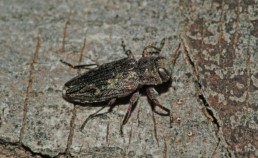
Identification and Damage Symptoms
The adult flat-headed apple borer is a metalic brown beetle, which can be found in Wisconsin during the summer months. Larvae are flat and pink-colored with a wide head. They overwinter as larvae inside the tree, and there is only one generation per year. Damage symptoms include a loss of tree vigor, evenutally causing death.
Monitoring and Control
Monitoring for flat-headed apple borer includes being on the lookout for wilting or unhealthy trees, then looking for areas of depressed and discolored bark and oozing sap. Cultural controls include being sure to promptly remove wrapping from the trunk of the trees after one season, and keeping the trees well-watered and healthy, as these both decrease the attractiveness of the tree to flat-headed apple borer. Additionally, if a problem does arise in your orchard, you can use trap logs, by lying freshly cut logs of any species, covered in a sticky substance, in the orchard. This will trap and kill ovipositing females. If damage is not yet extensive on an apple tree, it may be possible to save the tree by cutting away the damaged bark and finding and killing the larva. Chemical control options are listed in the table below. Other product recommendations can be found in the latest Midwest Fruit Pest Management Guide. As always, read and follow the label before spraying any pesticide.

Black Stem Borer
Black stem borer beetles were introduced in the United States in the 1930s, and have been an occasional pest on ornamental trees since that time. In the past seven years, black stem borer has become a pest of tree fruit in Michigan and New York State. The reason for this movement from ornamentals into orchards is unclear, as is the level of potential damage from this pest in the future.
In Wisconsin, black stem borer has not yet been found in an agricultural crop, but only in lumberyards and wood waste disposal sites. However, to be on the safe side, it would be good to learn to recognize this beetle and their damage symptoms, and to make sure you get in contact with one of us, or your local extension agent, if you suspect damage from the black stem borer in your fruit trees.
| Black Stem Borer | |
| Order | Lepidoptera |
| Family | Curculionidae |
| Scientific Name | Xylosandrus germanus (Blandford) |
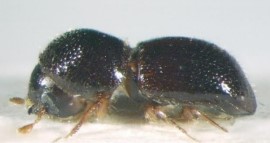
Identification and Damage Symptoms
Black stem borer beeltes are rarely seen outside of the tree; in fact, the males generally does not leave the galleries of tunnels within the tree, and only the female will fly to another location to mate and lay eggs. They are thought to have two generations per year in Michigan. Unlike our typical apple tree borers, black stem borer does not feed on the tree itself, but instead cultivates a fungus on the tree, and then feeds in turn on the fungus. Damage symptoms of the black stem borer include vertical lines of circular holes on the tree trunk, possibly with oozing sap or with sawdust and frass ‘toothpicks’ coming out of the holes.
Monitoring and Control
Monitoring is probably not necessary at this time, as there is no evidence to date of black stem borer in Wisconsin orchards. If you suspect damage, and would like to trap for the adult females, you can make your own trap by cutting a few windows into a 1- to 2-liter plastic container, then baiting it with vodka or antifreeze. The beetles are tiny (2 mm long), and require a microscope for positive identification. Cultural control, removing and burning any affected trees, is currently the recommended strategy for this pest. Chemical control options can be found in the Midwest Fruit Pest Management Guide. You should always fully read and follow the label before spraying any pesticide. Please note that systemic insecticides have no effect on black stem borers, as they do not feed directly on the tree, but only on the associated fungus.
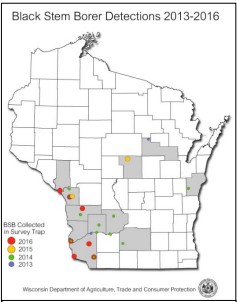
This article was posted in Insects.

